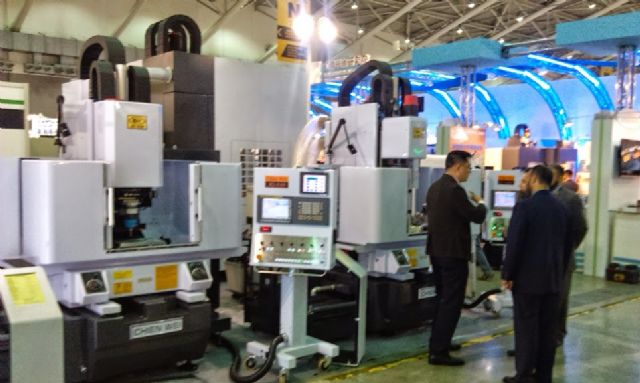Taiwan’s Machinery Exports Down a Second Month in April
Recently rallying NT-dollar saps competitiveness of Taiwanese machinery
2015/05/25 | By Ken LiuCompiled by KEN LIU

Taiwan’s machinery exports declined year-on-year for a second month in April due to a recently stronger NT-dollar relative to Japanese yen and South Korean won against U.S. dollar, according to the Taiwan Association of Machinery Industry (TAMI), which represents around 3,000 local machinery manufacturers.
On year-on-year basis, the Taiwan exports increased 25.7 percent to NT$56.7 billion (US$1.82 billion) in January, up 3.1 percent to NT$42.2 billion (US$1.36 billion) in February, but slipped 1.3 percent to NT$54.9 billion (US$1.77 billion) in March, and lost 4.6 percent to NT$51.1 billion (US$1.64 billion) in April.
Taiwan’s exports were US$6.51 billion throughout the first four months, inching up only 0.9 percent from the same period of last year, or NT$205.30 billion (US$6.62 billion) in NT-dollar, with industry executives fearing such exports will likely drop in the Jan.-May period.
Industry executives attribute the export reduction mostly to the relatively steeper devaluations of South Korean won and Japanese yen as well as the rallying NT-dollar, which depreciated favorably in April but has risen in May to render Taiwanese exports less competitive.
In the first quarter of this year, most of the island’s leading machine-tool makers saw earnings drop due to losses from foreign exchange transactions. TAMI Chairman B.X. Ke suggests that the government let the NT-dollar-to-greenback value devalue to 33:1 to shore up Taiwan’s export competitiveness.
Ke says the NT-dollar traded at 31.5:1 U.S. dollar on average in the first four months of this year, down 4.05 percent from the same period of 2014, and around 31.2:1 in April. But, it has recently risen to 30.7-to-1. Since 2007, the NT-dollar has depreciated 4.3 percent against the greenback, compared to the South Korean won’s 15.2 percent and Japanese yen’s 35 percent, he notes.
The depreciated yen has made Japanese-built high-performance machines much more cost-effective, which only further enhances their marketability. Japanese machinery is typically regarded as being higher quality relative to Taiwanese counterparts.
South Korean makers, in addition to steeper depreciation of the won, also benefit from Free Trade Agreement (FTA) the country has signed with major economies including the U.S., European Union, and mainland China.
Another threat looming is from mainland Chinese manufacturers that continually wrest shares from Taiwanese manufacturers of low-end, mid-range machine-tools. Such trend is generally inevitable as mainland Chinese operators gradually learn via cooperation with and working for Taiwanese makers, to slowly gain capacity and duplicate technologies to set up their own business. Similar processes happen in Taiwan among all kinds of businesses.
Ke says the island’s machinery industry faces unprecedented difficulty and the earlier touted projection for the industry’s revenue to top NT$1 trillion (US$32.25 billion) may be more hopeful thinking than realistic prospects. He urges the Taiwan government to accelerate negotiations with China to include the island’s machine-tool sector in the Cross-Strait Agreement on Trade in Goods, which is based on the Economic Cooperation Framework Agreement (ECFA) signed bilaterally in 2010, to offset impact from South Korea’s trade agreements.
The chairman says China was Taiwan’s largest export destination for machinery in the first four months, with purchase of US$1.79 billion, or 27.5 percent, of Taiwan-made machines to register a 9.1 percent year-on-year increase. The U.S. imported US$1.12 billion, or 17.2 percent, of Taiwan-built machines to register a 1.0 percent increase year-on-year to be the No.2 buyer. Japan purchased US$397 million, or 6.1 percent, of Taiwan-built machines, for a 3.7 percent decrease year-on-year to be the No.3 importer.
Taiwan exported machine tools totaling US$1.06 billion in Jan.-Apr. to post a 5.9 percent decrease year-on-year, with January export of US$287 million representing a 16.1 percent surge, February export of US$208 million for a 10 percent decrease, March export of US$302 million for a 9.8 percent contraction, and April export of US$269 million for a 15.7 percent plunge year on year.
China was also Taiwan’s top buyer of machine tools in the first four months, importing US$317 million, or 29.7 percent, of Taiwan-made machine tools for a 7.8 percent decrease year-on-year. The United States came in second to absorb US$123 million, or 11.6 percent, of Taiwan-built machine tools to register a 2.4 percent contraction year-on- year. Turkey was the No.3 buyer, importing US$64.58 million, or 6 percent, of Taiwan-made machine tools to register an 8 percent surge.
Taiwan’s exports of machine tools all saw drops to Thailand, Germany, Russia, South Korea, England, Italy, and Brazil in the first four months, but increased in growths to Holland, Japan, Malaysia, Vietnam and India.
Taiwan’s Exports of Machinery and Machine Tools (Jan.-Apr. ‘15)
| Category
| Machinery
| Machine Tool
|
| Export revenue
| US$6.51bn
| US$1.06bn
|
| YoY change (%)
| +0.9
| -5.9%
|
| Top-3 export destinations as Taiwan’s total exports
| Mainland China (27.5%) U.S. (17.2%) Japan (6.1%)
| Mainland China (29.7%) U.S. (11.6%) Turkey (6.0%)
|
| Note
| TAMI originally forecasted 10% increase year-on-year each for the island’s machinery and machine-tool exports for 2015.
| |

